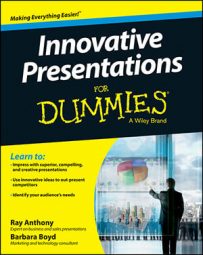When you are doing an innovative presentation for the director personality there are some things to keep in mind. Quintessential strong, steel-willed leaders exemplify Directors, who tend to be left-brain dominant people. Some think of these successful people as Type A personalities.
Read the typical characteristics, traits, attitudes, and behaviors that define this take-charge personality and think about who you know who fits the Director quadrant — it may be you:
Focuses on goals, results, action, and achievement
Highly competitive — loves tough challenges to overcome
Forceful, authoritative, commanding (large and in charge)
Wants it all yesterday
Demanding and impatient
Decisive and direct — blunt and opinionated in communication
Exerts control — of self and others
Seeks power, status, prestige
Big (often fragile) ego requiring feeding
Independent and self-sustaining — takes quick initiative
Does not allow himself to show vulnerable emotions or any sign of weakness
Opportunist — a smart risk-taker and methodical innovator
Directors make decisions more quickly than any other personality type — if you present the right type of information to them. People in positions in power are likely to be Directors. High-powered individuals have to make lots of decisions in their job.
They cannot afford to overanalyze, procrastinate, or delay things. They want to see results and to move ahead quickly and purposefully. Sure, they take prudent, calculated risks, but if they see something they view as beneficial to them, they jump on it.
At the extreme end of this profile, Directors can be Attila the Hun types — ruthless, tyrannical, control-freak bullies who ride rough-shod over people with their domineering personalities, gruff style, and cold-hearted obsession to gain power and riches by exploiting others. They see people as simply a means to an end.
At their best, Directors are superb visionaries and commanding, well-intentioned leaders who take care of their people and bring impressive, positive change to an organization or country. They can be prolific producers with major accomplishments. Their take-charge abilities and cool-under-fire demeanor are invaluable in an urgent or crisis situation.
How to identify a Director within a minute in your innovative presentations
A Director’s body language, voice, and behavior typically show the following traits:
Direct
Fast-talking
Loud voice
Formal
Reserved, even closed
Unemotional
Down to business
How to best present to Directors in your innovative presentations
Directors respect presenters with high credibility who show self-assurance and competence and exhibit good leadership qualities while presenting. Directors expect you to thoroughly and accurately do your homework and cover the critical, priority information (without extraneous details) they need to make a good decision. You must be clear, concise, direct, and specific about how your recommendation fits and improves the vision, mission, and goals of the Director’s organization.
Open your presentation with a crisp, sharply focused executive summary of the projected results. Directors’ interests lie in improving productivity, efficiency, quality, and innovation to generate higher profits and an attractive return on investment for their organization.
Plan your presentation thoroughly and meticulously. Be organized and fully prepared to have reserve information available if the Director needs it. Stick to business and get right to the point without being abrupt. Be personable, but reserved and professional at all times. Build a rock-solid, attractive business case using provable facts, statistics, and other empirical information.
Directors respect presenters who are composed, poised, and relaxed, but who can also show their steely resolve, conviction, and firmness when needed.
Communicate viable options and choices with realistic pros and cons and have key information for Directors to compare to aid them in deciding. Focus on strategic (high-level) issues and minimize the tactical (detailed, lower-level) information.
Avoid the following behaviors when presenting to Directors:
Don’t ramble, be vague or elusive, or give unprepared extemporaneous answers to questions.
Don’t become emotional or make emotional appeals.
Don’t get personal or be cute, witty, or clever with these all-business types.
Don’t exhibit fear and don’t hesitate or vacillate when challenged.
Don’t leave gaps or loose ends in your presentation.
Directors like appropriate, purposeful creativity in your presentation as opposed to window dressing or entertaining creativity. If your imaginative approach or creatively designed visual media can better highlight key information, spotlight important comparisons, or otherwise aid in their decision-making process, bring it on.

